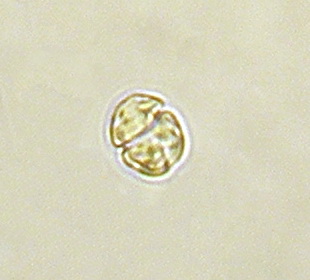
Gymnodinium is a genus of dinoflagellates, a type of marine and freshwater plankton. It is one of the few naked dinoflagellates, or species lacking armor known as cellulosic plates. Since 2000, the species which had been considered to be part of Gymnodinium have been divided into several genera, based on the nature of the apical groove and partial LSU rDNA sequence data. Amphidinium was redefined later. Gymnodinium belong to red dinoflagellates that, in concentration, can cause red tides. The red tides produced by some Gymnodinium, such as Gymnodinium catenatum, are toxic and pose risks to marine and human life, including paralytic shellfish poisoning.

Karenia brevis is a microscopic, single-celled, photosynthetic organism in the genus Karenia. It is a marine dinoflagellate commonly found in the waters of the Gulf of Mexico. It is the organism responsible for the "Florida red tides" that affect the Gulf coasts of Florida and Texas in the U.S., and nearby coasts of Mexico. K. brevis has been known to travel great lengths around the Florida peninsula and as far north as the Carolinas.

Karenia is a genus that consists of unicellular, photosynthetic, planktonic organisms found in marine environments. The genus currently consists of 12 described species. They are best known for their dense toxic algal blooms and red tides that cause considerable ecological and economical damage; some Karenia species cause severe animal mortality. One species, Karenia brevis, is known to cause respiratory distress and neurotoxic shellfish poisoning (NSP) in humans.
Karlodinium is a genus of athecate dinoflagellates. They are often toxin producing, and compared to the other members of the Kareniaceae, are fairly small at <8-15 µm diameter.
Gambierdiscus belizeanus is a species of dinoflagellate, first found in Belize.
Coolia tropicalis is a species of dinoflagellates, first found in Belize.
Gambierdiscus pacificus is a species of toxic dinoflagellate. It is 67–77 μm long and 60–76 μm wide dorsoventrally and its surface is smooth. It is identified by a four-sided apical pore plate surrounded by 30 round pores. Its first plate occupies 20% of the width of the hypotheca.
Gambierdiscus australes is a species of toxic dinoflagellate. It is 76–93 μm long and 65–85 μm wide dorsoventrally and its surface is smooth. It is identified by a broad ellipsoid apical pore plate surrounded by 31 round pores. Its first plate occupies 30% of the width of the hypotheca.
Gambierdiscus polynesiensis is a species of toxic dinoflagellate. It is 68–85 μm long and 64–75 μm wide dorsoventrally and its surface is smooth. It is identified by a large triangular apical pore plate, a narrow fish-hook opening surrounded by 38 round pores, and a large, broad posterior intercalary plate. Its first plate occupies 60% of the width of the hypotheca.
Takayama tasmanica is a species of dinoflagellates with sigmoid apical grooves first found in Tasmanian and South African waters. It contains fucoxanthin and its derivatives as its main accessory pigments.
Takayama helix is a species of dinoflagellates with sigmoid apical grooves first found in Tasmanian and South African waters. It contains fucoxanthin and its derivatives as its main accessory pigments.
Karenia papilionacea is a species from the genus Karenia, which are dinoflagellates. It was first discovered in New Zealand.
Karenia bicuneiformis, also known as Karenia bidigitata is a microbial species from the genus Karenia, which are dinoflagellates. It was first discovered in New Zealand.
Takayama tuberculata is a species of unarmored dinoflagellates from the genus Takayama, being closely related to T. tasmanica. It was first isolated from the Australian region of the Southern Ocean, just north of the polar front. It is medium-sized and is characterized by its long ovoid cell shape and rather long apical groove. It is considered potentially ichthyotoxic.
Karlodinium antarcticum is a species of unarmored dinoflagellates from the genus Karlodinium. It was first isolated from the Australian region of the Southern Ocean, near the polar front. It is medium-sized and is characterized by its long ovoid cell shape and rather long apical groove. It is considered potentially ichthyotoxic.
Karlodinium ballantinum is a species of unarmored dinoflagellates from the genus Karlodinium. It was first isolated from the Australian region of the Southern Ocean. It is small-sized and is characterized by its very short apical groove. It is considered potentially ichthyotoxic.

Gambierdiscus is a genus of marine dinoflagellates that produce ciguatoxins, a type of toxin that causes the foodborne illness known as ciguatera. They are usually epiphytic on macroalgae growing on coral reefs.

Dinoflagellates are eukaryotic plankton, existing in marine and freshwater environments. Previously, dinoflagellates had been grouped into two categories, phagotrophs and phototrophs. Mixotrophs, however include a combination of phagotrophy and phototrophy. Mixotrophic dinoflagellates are a sub-type of planktonic dinoflagellates and are part of the phylum Dinoflagellata. They are flagellated eukaryotes that combine photoautotrophy when light is available, and heterotrophy via phagocytosis. Dinoflagellates are one of the most diverse and numerous species of phytoplankton, second to diatoms.
Coolia is a marine dinoflagellate genus in the family Ostreopsidaceae. It was first described by Meunier in 1919. There are currently seven identified species distributed globally in tropical and temperate coastal waters. Coolia is a benthic or epiphytic type dinoflagellate: it can be found adhered to sediment or other organisms but it is not limited to these substrates. It can also be found in a freely motile form in the water column. The life cycle of Coolia involves an asexual stage where the cell divides by binary fission and a sexual stage where cysts are produced. Some of the species, for example, Coolia tropicalis and Coolia malayensis, produce toxins that can potentially cause shellfish poisoning in humans.
Kareniaceae is a family of dinoflagellates belonging to the order Gymnodiniales.



